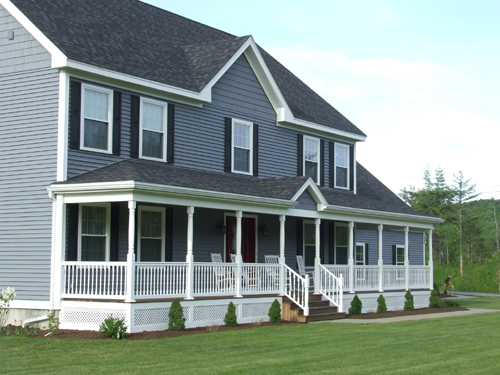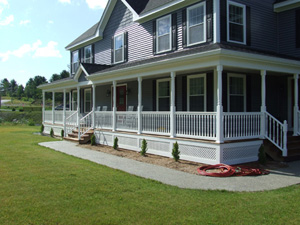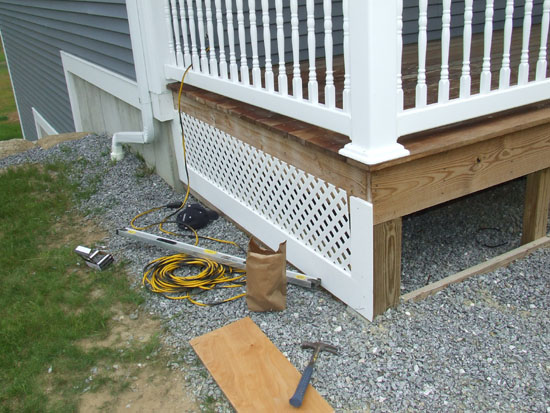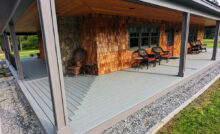Porch Skirt for Farmers Porch


Farmers Porch With Lattice Skirt
The farmer’s porch in the adjacent photo has a complete pvc lattice skirt around the bottom of the porch framing. Raised porches look best with some sort of skirt to hide the framing and keep small animals and children out of the space.
Materials
The entire porch skirt is built from pressure treated framing, 1-inch pvc trim and vinyl lattice. Not having to paint this lattice is a really important feature to us. We have no desire to spend summers doing endless maintenance.
It’s VERY important that you understand how to work with PVC trim before tackling a project like this. While that discussion is far too lengthy for this article it is worth noting some key considerations:
- Thermal Movement – PVC trim expands and contracts more than traditional wood trim. Because of that the material must be fastened according to the manufacturers specifications. This typically includes using more fasteners and shorter intervals. We typically use either stainless steel ring shank siding nails or stainless steel trim screws.
- Glue Joints – Gluing the joints is almost 100% necessary in our experience to prevent sightly opening. We typically glue all miter and scarf joints with “clear” pvc cement (this means both clear primer and glue). Gluing the joints has proven very effective in combination with proper fastening to keeping the joints nice and tight.
- Don’t Be Afraid To Paint It – While many people think that PVC trim doesn’t need to be painted (it doesn’t really) it does look much nicer if you do. The paint helps hide the fasteners and joints. The beauty is most paints will last a very long time on PVC as the substrate will not absorb water which is the normal cause of paint failure.
How To Build Lattice Porch Skirt
I won’t go into much detail in this article about the specific steps in building the porch skirt. If you’d like to learn how to build a lattice porch skirt like this one then check out the series of posts that we wrote on how to build a porch skirt.
Basically the skirt is created by building a “frame” that will hold the lattice in place. The frame is constructed of 3/4″ thick KLEER Trimboard material that I rabbited to hold the lattice. The rabbit detail allows the lattice to move with changes in temperature without buckling. Each lattice panel just sits in the slot and is not nailed or screwed in place.
I’m happy to say that after 5 seasons not one single joint has opened up and the lattice still looks as good as new.
Recent Posts
Framing Stick Nailer vs Coil Nailer
Which is Better a Stick Nailer or Coil Nailer? Framers have many choices in nailers…
How Many Roofing Nails Per Square of Shingles
Estimating How Many Nails for a New Roof When it comes to estimating materials for…
Composite / PVC Decking – Layout Tips & Advice
Composite / PVC Decking Layout Tips and Advice Composite and PVC decking have really changed…
Benefits of an ERV System (Energy Recovery Ventilator)
Benefits of ERV Systems (Energy Recovery Ventilator) If you're building a new home or doing…
Vermiculite Attic Insulation Abatement
Vermiculite Attic Insulation If your home was built before 1990 there is a chance it…
Nuisance Tripping of AFCI (Arc Fault) Circuit Breakers
Arc Fault (AFCI) Circuit Breakers Tripping Often An arc-fault circuit interrupter (AFCI) or arc-fault detection…




View Comments
This is the perfect porch!
This is the Perfect Porch!
Hi Todd
your porch looks great. Can you please let me know an estimated cost to build a farmers porch? We live in northern NH, own a 48' long pre-fab home and are planning to add a 48'X6' farmers porch along the front. Very much like yours actually. Roof, front steps, rails and completely open on one end; I am only looking for an estimated cost at this time and will be getting a quote from a contractor, but am interested in a ball park figure.
Thanks
J.L.
Farmers Porch Cost
It's hard to say what my porch cost because so much of it was combined with building the house. However, when we build similar porches for customers they run from $50 per sq. ft. to $100 per sq. ft. depending on the type of materials.
This porch would probably cost at least $20,000 as built. People are usually surprised at the cost but they are quite labor intensive. You also have to install some type of foundation, piers etc, pressure treated framing lumber, decking, railing, ceiling, roof framing, shingles, etc.
Hope that helped and didn't scare you off too bad.
Congratulations! The porch turned out fabulous!
Todd,
I am in the process of adding vinyl porch railing to my website (white, black, tan, gray and clay/adobe colors) and wondered if you had an opinion on vinyl/aluminum railing versus wood railing (yours appears to be wood from the picture. In my experience, the aluminum/vinyl rails seem to be easier to install (especially for non-professional DIYers) and if you look at the maintenance factor, are less expensive over the life of the product.
Hmmm, I think I just came up with another good idea to post on my blog! LOL
Keith
@ Keith - Those railings are actually vinyl (Certainteed). I really like the vinyl railings especially for the ease of installation. We've recently installed quite a few composite railing systems that I like even better, however, they are harder to install. I wouldn't consider a wood railing today! Too much maintenance.
Great post!
Now you have to screen that in to keep out those "sparrow sized" mosquitos you have up there!
Finally - a tutorial on building a lattice porch skirt. Been looking for one that doesn't just mention deck building for a while now.
This is great Todd (just discovering it), as it is a project that I must tackle myself in the next few months. Whereas you nailed to new porch framing, and kudos on killing two birds with one stone btw, I'll have to sit my up and under the already existing skirt and between brick and stone piers. (How I am going to hold the assembly in place not sure yet.) I was going to set out looking for a pre-cut vinyl channel, but if I can't find it I'll likely be pulling off a similar install. I appreciate the reminder of pvc's performance characteristics. Great info. cheers, thanks and happy 4th. ~jb
Hello! Wondering if I could get your ideas on this same pvc lattice but my house is on a hill and do you think it would look good on a slant? My porch runs any where from 18" to 4' in the front.
Absolutely. There are many homes with that type of detail. Just need to make sure the frame also follows the slope. Good luck.